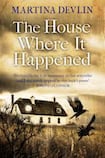
A community spurred to hysteria through superstition, suspicion and malice. The terrifying power of mob rule. False accusations and mindless persecution. Ordinary women on trial for witchcraft, their guilt a matter of opinion, not evidence. An illogical world undercut by fear of both the ruling elite and supernatural forces. Or, as Mrs Putnam from The Crucible puts it: "There are wheels within wheels in this village, and fires within fires!"
A chilling parable of McCarthyism in the United States of the 1950s, Arthur Miller’s classic dramatisation of the Salem witch trials takes place in 1692. Nineteen years later the state of Massachusetts retracted the accusations and reinstated the good names of the women who had been condemned, many of whom had been executed.
That same year the last conviction for witchcraft in Ireland was handed out in Carrickfergus, Co Antrim, to a group of women whom a teenager had accused of witchcraft. A pretty and innocent-looking girl, this same Mary Dunbar is the driving force of Martina Devlin’s new novel.
Fictionalising a horrific and little- known episode of Irish history, Devlin tells an absorbing tale of bloodlust and betrayal. Two stories are interwoven: the 1711 witch-hunt and the massacre of the people of Islandmagee in 1642 at the hands of Scottish forces. Devlin creates for this latter story the murderous Hamilton Lock, whose brutal slaying of women and children comes back to haunt the community years later.
The haunting takes place at Knowehead House, home of the Haltridge family and their servants. Ellen Hill, a housemaid, is the narrator, a captivating young voice who paints a convincing picture of fear and finger-pointing within the community.
Mistress Isabel Haltridge, bitter and brittle, invites her cousin Mary Dunbar to stay at Knowehead while her husband, James, is away on business. Bored by the lack of social life in her new environment, cousin Mary soon finds herself entertained.
Whether the witches that torment and abuse her are of her own devising or of more malevolent origins – perhaps linked to Lock and his ghosts – remains unclear and gives the narrative tension.
There is much to like in this book, not least Devlin's assured hand when it comes to the customs and dialect of the era. The Omagh-born author is a columnist for the Irish Independent who has written seven previous books, including other historical fiction, such as Ship of Dreams (2007).
The patterns of colloquial speech are expertly mixed into the narrative – “forbye”, “visog”, “allus”, “pockle” – and a glossary at the back shows the research that went into this. There is a clear sense of setting and voice right from the opening line: “It poured fit to need the Ark again when Mary Dunbar came among us.”
The hardship of peasant life is well rendered, from a fear of those in power – the minister, the mayor, the merciless Constable Brice – to the dangers of challenging these orders. Misogyny is rife in Islandmagee, a terrible place to be a poor woman. This is seen through the predilection for accusing peasant women, but also highlighted by Ellen’s character, who works tirelessly for an ungrateful mistress and drinks vile potions in order to miscarry her master’s child.
Despite her bleak situation, young Ellen is a likeable and no-nonsense narrator. Her humorous take on the madness she witnesses enlivens the dark subject matter: “The thought of eternal damnation left me feeling queasy, so it did.” Flashes of humour appear throughout. A puritan minister has a horse called Sobriety. Master James woos the plain-looking Ellen: “You’re like a candle, straight and tall.”
Powerless and uneducated, the locals cling to tradition and superstition. Women are condemned by consensus and with skewed logic: “The guilty cannot look upon those they have wronged without giving themselves away.” Alibis are no good either: “Witches can send their shapes to do their bidding when their bodies are somewhere else.”
Pacing is an issue, and the narrative lacks dramatic structure. The tension between the real world and the paranormal that sustains the story for much of the book lessens in the final quarter. Mary Dunbar is a nicely ambiguous character, but the questions that have been set up behind her motivations are never fully answered. The trial of the alleged witches should be a climax, but we have spent little time with any of the condemned, so it is hard to care about their outcome. Were a more central character in the dock, the stakes would be higher.
These issues aside, The House Where It Happened is an interesting retelling of a strange and terrible time when individuals projected their own shames outward. It is reminiscent of Miller's "arena of morality" where petty grudges and fears are elevated to gruesome persecution in the name of God.












